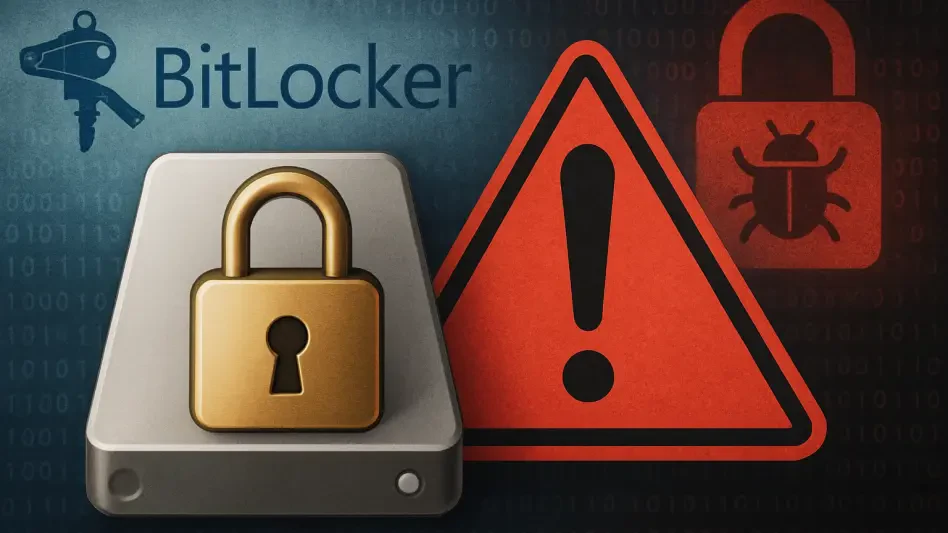Imagine a scenario where a trusted encryption tool, relied upon by millions to safeguard sensitive data on Windows devices, is suddenly rendered vulnerable by hidden flaws that allow attackers to access encrypted information with alarming ease. This is the unsettling reality uncovered by security researchers who have identified critical zero-day vulnerabilities in Microsoft’s BitLocker encryption system. These flaws, which exploit the Windows Recovery Environment (WinRE), have exposed a significant gap in data protection for users across various Windows versions, including Windows 10 and 11. Dubbed “BitUnlocker,” this research reveals how attackers with physical access to a device can bypass BitLocker’s safeguards, decrypting protected volumes and gaining unauthorized entry to confidential data. The discovery raises urgent questions about the security of encryption tools and the broader implications for organizations and individuals who depend on them to secure critical information in an increasingly threat-laden digital landscape.
Uncovering the Vulnerabilities in BitLocker
Security researchers from Microsoft’s Offensive Research & Security Engineering team have brought to light four zero-day vulnerabilities that strike at the heart of BitLocker’s protection mechanisms. Identified as CVE-2025-48800, CVE-2025-48003, CVE-2025-48804, and CVE-2025-48818, these flaws target distinct weaknesses within the Windows Recovery Environment, a system intended to assist in troubleshooting critical issues. Instead, WinRE has become an unintended attack surface, with vulnerabilities allowing manipulation of external configuration files and data. Attackers can exploit elements like Boot.sdi files or ReAgent.xml parsing to undermine encryption safeguards. What unites these exploits is the prerequisite of physical access to the device, highlighting a critical reminder that hardware security remains as vital as software defenses in protecting sensitive information from determined adversaries seeking to decrypt and access protected volumes.
The sophistication of these vulnerabilities lies in their diverse attack vectors, each revealing a unique method to bypass BitLocker’s encryption. For instance, some exploits leverage trusted applications for persistent unauthorized access, while others redirect boot configurations to unlock encrypted data. This variety underscores the complexity of securing recovery environments, which are often overlooked as potential entry points for malicious actors. The research, set to be showcased at a prominent cybersecurity conference under the title “BitUnlocker: Leveraging Windows Recovery to Extract BitLocker Secrets,” emphasizes the ingenuity of attackers who can exploit even the most benign system components. It also serves as a wake-up call for the industry to reassess the security of tools designed for system recovery, ensuring they do not inadvertently provide backdoors for exploitation when physical access to a device is obtained by unauthorized individuals.
Microsoft’s Response and Mitigation Efforts
In a swift and decisive reaction to the discovery of these critical vulnerabilities, Microsoft released a comprehensive set of security patches during the July Patch Tuesday update. These updates, identified by KB numbers such as KB5062552 and KB5062560, address the flaws across multiple Windows versions, including both client and server editions. With CVSS scores ranging from 6.8 to 8.1, the likelihood of exploitation is deemed significant, prompting urgent action from the tech giant to protect users. The patches aim to close the gaps in WinRE that allow attackers to bypass BitLocker encryption, reinforcing the system’s integrity against physical access exploits. This response demonstrates a commitment to maintaining trust in encryption solutions, especially as cyber threats continue to evolve and target even the most robust security tools with increasing sophistication.
Beyond the deployment of patches, Microsoft has also issued detailed guidance on additional protective measures to fortify BitLocker against similar threats. Recommendations include enabling TPM+PIN for pre-boot authentication, which adds an extra layer of security by requiring a personal identification number alongside hardware-based protection. Additionally, implementing REVISE mitigation for anti-rollback protection is advised to prevent attackers from downgrading system components to exploit older vulnerabilities. These strategies reflect a defense-in-depth approach, acknowledging that while patches address immediate flaws, long-term security requires multiple barriers to deter physical bypass attempts. For organizations and individuals relying on BitLocker, adopting these countermeasures alongside the latest updates is crucial to safeguarding encrypted data from potential breaches stemming from direct device access.
Implications for Cybersecurity and Future Defenses
The discovery of these zero-day flaws in BitLocker serves as a stark reminder that no encryption tool, no matter how widely trusted, is immune to vulnerabilities—especially when physical access to a device is a factor. This research highlights a broader trend in cybersecurity where attackers continuously seek out and exploit overlooked components, such as recovery environments, to undermine even the strongest defenses. The implications extend beyond individual users to organizations that store sensitive data on Windows devices, urging a reevaluation of security protocols to account for physical tampering risks. As threats evolve, the need for continuous assessment and improvement of encryption mechanisms becomes evident, ensuring that systems remain resilient against both digital and physical attack vectors in an era of increasingly sophisticated cybercrime.
Looking ahead, the BitUnlocker findings underscore the importance of proactive security research conducted by internal teams to identify and address potential exploits before they are weaponized by malicious actors. The industry must prioritize a layered security approach, combining software updates with hardware protections and user education to mitigate risks. For BitLocker users, staying vigilant about applying updates and implementing recommended safeguards is paramount. Moreover, this incident prompts a broader conversation about designing recovery systems that are inherently secure, minimizing the attack surface they present. As cybersecurity challenges persist, fostering collaboration between researchers, vendors, and users will be essential to anticipate and counter emerging threats, ensuring that data protection tools evolve to meet the demands of a dynamic threat landscape.
Reflecting on a Critical Security Lesson
The revelation of the BitLocker vulnerabilities through the BitUnlocker research marked a pivotal moment in understanding the limitations of encryption when faced with physical access exploits. Microsoft’s rapid deployment of patches and detailed mitigation guidance addressed the immediate risks posed by these flaws, setting a precedent for responsive action in the face of zero-day threats. Organizations and individuals who applied the July updates and adopted enhanced protections like TPM+PIN took significant steps toward securing their data. This episode served as a powerful lesson in the necessity of vigilance, reminding all stakeholders that cybersecurity is an ongoing battle requiring constant adaptation. Moving forward, the focus must remain on integrating robust safeguards into every layer of technology, anticipating potential weaknesses, and ensuring that encryption tools are fortified against both current and future risks through sustained innovation and collaboration.








